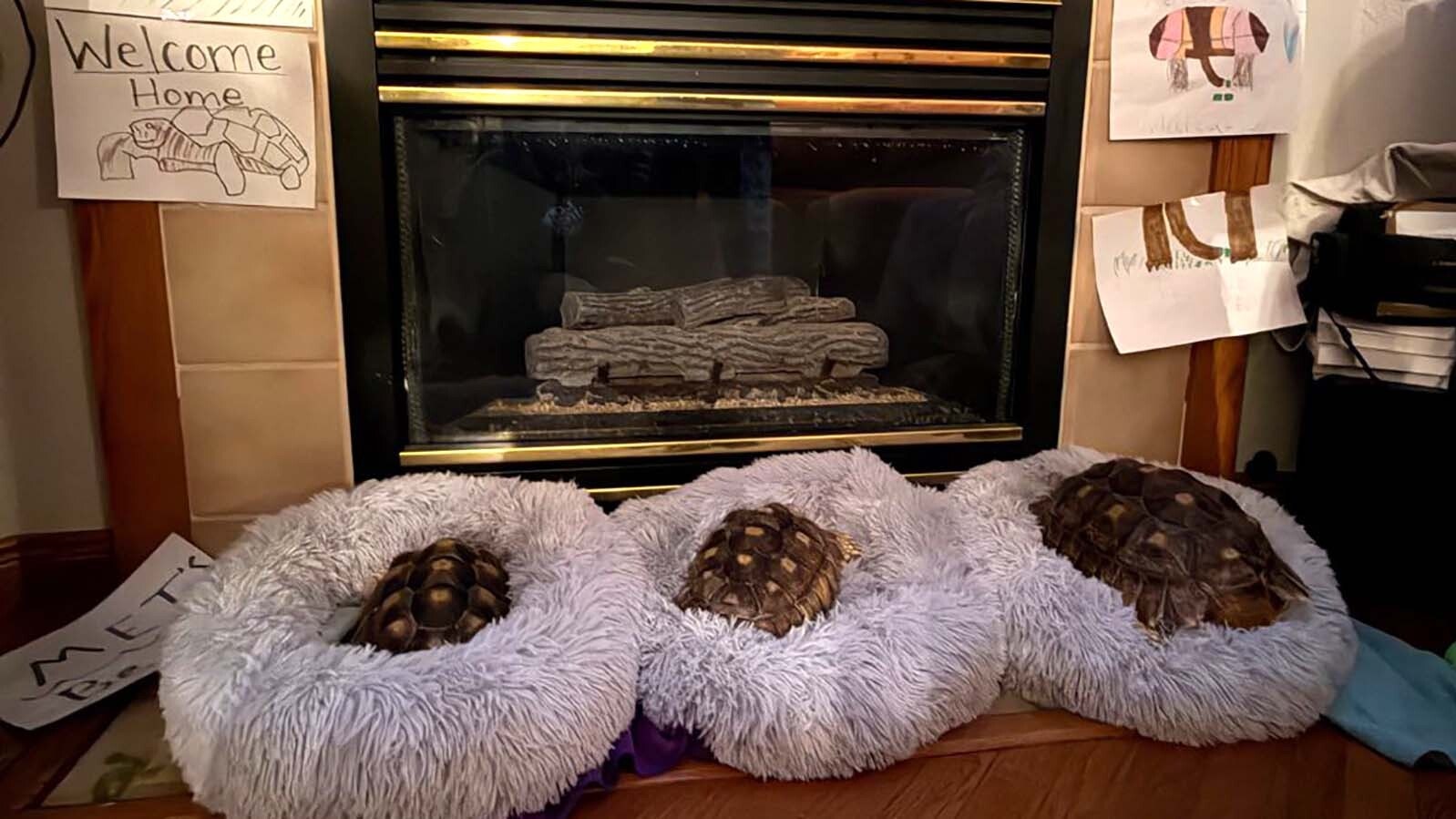Andrew Milner, the lead paleontologist at the St. George Dinosaur Discovery Site in St. George, Utah, is exhausted. He’s had one day off in the last three weeks of 12-hour days as he oversees an unprecedented frenzy of excavation and discovery along the shores of a prehistoric lake.
The city of St. George is building a power substation on an acre of Early Jurassic lakefront real estate. But before they break ground, they gave Milner and an army of volunteers two months to break every inch of ground to search for exquisite scrap of plants, teeth, bones, and footprints during the "substation excavation."
Milner's been going non-stop since the beginning March, and he's not stopping until St. George tells him to stop.
“I’ve been camping on site rather than driving home,” Milner told Cowboy State Daily. “My wife misses me, but it’s hard to stay away. There’s so much discovery.”
Finding Their Stride
St. George sits on the red rocks of the 200-million-year-old Moenave Formation. It preserves fossils from a critical point in prehistory when the dinosaurs established their 135-million-year dynasty.
In the aftermath of a mass extinction at the end of the Triassic Period, dinosaurs found their stride in the Early Jurassic Period. Those strides and much more are preserved in phenomenal quality at the St. George Dinosaur Discovery Site.
“We have one of the best dinosaur track sites in North America and the world,” Milner said. “Our site preserves dinosaur tracks and shows behavior from walking, running, swimming, and limping dinosaurs.”
One of the site's most unique tracks reveals how meat-eating dinosaurs sat. The impressions of a theropod's feet, tail, and arms are preserved on what was once the shore of a prehistoric lake, roughly the size of modern-day Lake Erie.
“Our site's famous for that unique sitting trace fossil,” Milner said. “It was the first trace evidence of how the limbs of these animals were positioned in life. It shows they could a basketball but couldn’t dribble it.”
The most famous dinosaur denizen of the Early Jurassic Period was Jurassic Park's Dilophosaurus. The actual Dilophosaurus, a 20-foot-long apex predator with its unusual double-crested head, was quite different from the knee-high, frilled, venom-spitting monster depicted in the franchise.
A large section of these exceptional tracks sits under the roof of the St. George Dinosaur Discovery Site, which opened in 2005. Milner is the curator and lead paleontologist of the on-site museum, which sees around 60,000 visitors annually.
Dinosaur footprints lie underneath the entire St. George community, and more fossils are found as the Moenave Formation is exposed during new construction projects. The latest project has turned St. George and its prehistoric plethora of fossils into the international spotlight.
Fossil Frenzy
The city of St. George needs a new power substation. They selected an acre of land across the street from the St. George Dinosaur Discovery Site as the location.
Milner knew a bounty of unique fossils could be destroyed during construction. So, the city of St. George allowed him to break ground and collect these priceless pieces of history before they broke ground on the substation.
“We were told the city wanted to break ground in May,” he said. “We started digging at the beginning of March.”
The word went out: volunteers were needed in St. George for a small window of intense excavation. People from the community, the state, and the nation answered the call.
“We’ve had over 200 volunteers sign up to assist,” Milner said. “Professionals from universities and museums are jumping in to help. We're getting lots of donations of money and equipment, including a 40-foot shipping container for storage.”
Milner has already hosted field crews of students from Utah State University, the University of Texas-Austin, Idaho State University, and the Natural History Museum of Utah.
“Tylor Birthisel was an intern at the St. George Site,” Milner said. “Now he’s the preparation lab manager at the Natural History Museum of Utah. He’s coming back next week with Tyler Faith, the museum’s curator of paleontology.”
Construction companies have also donated time and equipment to the substation excavation. Canyon Crest Contractors, A.B. Excavation, and Handy Excavation have brought their heavy machines to simultaneously remove the overlying layers of rock and sediment while breaking into the fossil layers to give volunteers places to start digging.
Donations have been pouring into the museum, and there’s been more press coverage of the museum and excavation than ever before. Danny Anduza, a paleontology Twitch streamer, visited the site to drum up more support for the substation excavation.
“I cannot express how thankful I am to him for all he’s done,” Milner said. “We're getting so many donations, thanks to Danny.”
Milner’s highest praise goes to the city of St. George. While many people have been critical of the city, assuming a disregard for their rich fossil heritage, Milner said that couldn’t be further from the truth.
“This isn’t a crisis with the city,” he said. “The city of St. George is helping us out in a big way. They’ve provided dump trucks to help move rock offsite and they’re giving us time to collect these fossils.
“I have always wondered how much the city and its residents like our museum, but a lot of amazing residents are coming forward and helping because they absolutely love this place. It’s been amazing.”
Fruit Of The Labor
The substation excavation is an ongoing success. Decades of scientific opportunity have been exposed in the last three weeks, and Milner expects a lot more to be revealed in the next month.
“I thought we already had enough to work on, but we keep adding to the pile,” he said. “I had to close our preparation lab to volunteers so we could make more room for fossils.”
The spoils of the scientific endeavor include the skeletons of coelacanths, various fossils from crocodylomorphs, insect trace fossils, a wide variety of unique plants, and an entirely new layer of dinosaur tracks.
The dinosaur fossils recovered include several teeth, including one over four inches long. That’s not particularly big by dinosaur standards, but it’s the largest ever found in St. George.
“That one was found by a couple breaking up rocks in a rock pile,” Milner said. “They had never done this before, and the woman was in tears when she found it. I love encouraging people about this stuff, which was really exciting.”
That tooth might have belonged to the famous Dilophosaurus, but it's too early to tell. No definitive Dilophosaurus fossils have been found in the substation excavation, but it's entirely possible a small part of the apex predator could turn up.
Another exciting find are the outwardly unassuming iron concretions. Each is being saved and stored because Milner knows incredible fossils are waiting inside.
“The concretions look ugly, but we know beautiful fossils are preserved inside,” he said. “We have over 30 fish specimens, some potentially new species. They’ll be spectacular fossils once they’re prepared.”
Milner hypothesizes that theropod dinosaurs and crocodiles feasted on fish caught in the shallows of the prehistoric lake, which would explain the abundance of worn, broken teeth and partially desiccated fish preserved in the rocks.
Survivor: St. George
Since rock formations from this period of geologic time are rare, every discovery gives new insight into the 200-million-year-old world. Milner highlighted the plants, many of which are unique to the exposures of the Moenave Formation in St. George.
“Some of these mudstone layers preserve fragmentary and complete fossils of conifer branches and insects,” he said. “This layer comes from the earliest Jurassic in western North America, and there's hardly anything that can be excavated to this extent. Many plants and fish we’ve found are unique to this site.”
The Moenave Formation was also deposited shortly after the Triassic-Jurassic extinction event, when entire lineages of reptiles and mammal-like reptiles went extinct. It left a mostly empty world that the dinosaurs quickly conquered and dominated for the next 135 million years.
Every find is exciting. Milner doesn’t expect a complete skeleton of a 20-foot dinosaur to turn up at the substation excavation, but every scrap of bone or small tooth from a turtle, pterosaur, mammal, or dinosaur is a huge find.
Still, there are some fossils on Milner’s substation excavation bucket list.
“I’d like to find the femur of a theropod dinosaur and the teeth of the plant-eating dinosaurs living at the time,” he said. “We have the footprints of plant-eating dinosaurs, so finding their teeth would be cool. I’m hoping we might come across a theropod dentary, and there’s the possibility we could. That could be the first new species of dinosaur from St. George."
A Bigger Footprint
Paleontologists will be pouring over the specimens recovered during the substation excavation for decades. Milner is making the most of the moment by drawing attention to the importance and opportunity of the St. George Dinosaur Discover Site.
One of the museum's biggest problems is storage. Milner was already running out of space, and now he has an acre of rock that needs to be curated and protected.
“We've pulled out a couple of plaster jackets that are about 300 pounds with big fish fossils inside,” he said. “We've got to find more storage space. We need to get this stuff inside and out of the weather. When they’re locked up in the rock, they’re safe. Now we're exposing them, and they’re susceptible to the weather and vandalism.”
Milner wants to build a new museum on a five-acre lot near the St. George Dinosaur Discovery Site. The facility will increase the storage space available for fossils, serve as a repository for specimens from state and federal lands, and preserve another large expanse of pristine dinosaur tracks on the site.
“This is a world-class fossil site, and we’re making a lot of exciting discoveries,” he said. “There's so many significant research projects to do here, and we need a facility to preserve and study it.”
Right now, the five-acre lot is being covered with rock piles from the substation excavation. Volunteers will process these piles in the future, meaning fossils from the excavation will continue to be found long after the substation is built.
Milner admits he’s a bit overwhelmed now, but he does not intend to stop. He’ll keep working 12-hour days until he and his army of volunteers have searched every inch of the acre while “keeping up the momentum” to get St. George and the world behind his vision for the future.
“It’s hard to stay away,” he said. “This is a massive project, but with the great volunteers, teams, and professionals coming out to help us, I’m confident we’ll find even more unique discoveries. And getting to meet and work with all the people coming to St. George to help is amazing.”
Contact Andrew Rossi at arossi@cowboystatedaily.com

Andrew Rossi can be reached at arossi@cowboystatedaily.com.












